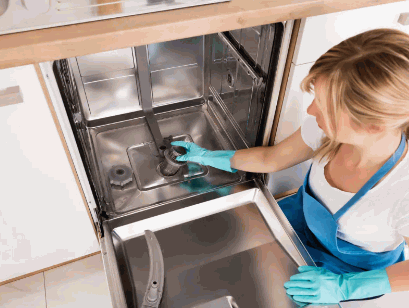Table Of Contents
- 1 Why Is It Important To Clean The Drain Of Dishwasher?
- 2 What Are The Signs That A Dishwasher Drain Needs To Be Cleaned?
- 3 What Are The Materials Needed To Clean The Drain Of Dishwasher?
- 4 How To Clean The Drain Of Dishwasher?
- 4.1 Step 1: Remove The Dishwasher's Bottom Rack
- 4.2 Step 2: Locate The Drain And Remove Any Debris
- 4.3 Step 3: Clean The Drain With Vinegar And Baking Soda Solution
- 4.4 Step 4: Rinse The Drain With Hot Water
- 4.5 Step 5: Remove And Clean The Filter
- 4.6 Step 6: Check The Drain Hose For Clogs
- 4.7 Step 7: Reassemble The Dishwasher And Run A Test Cycle
- 5 How Often Should The Dishwasher Drain Be Cleaned?
- 6 What Are The Alternative Methods To Clean The Drain Of Dishwasher?
- 7 How To Prevent Future Clogs In The Dishwasher Drain?
Are you noticing water pooling at the bottom of your dishwasher or a funky smell emanating from it? It might be time to clean the drain of your dishwasher.
This guide will discuss why it is important to clean the dishwasher drain, the signs that indicate it needs cleaning, the materials required, and a step-by-step process to effectively clean the drain.
We will also explore how often the dishwasher drain should be cleaned, alternative methods for cleaning, and tips to prevent future clogs. Let's ensure your dishwasher runs smoothly and efficiently!
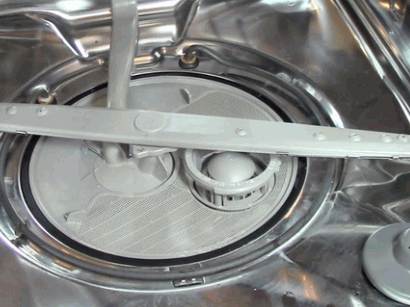
Why Is It Important To Clean The Drain Of Dishwasher?
Cleaning the drain of a dishwasher is crucial to prevent clogs, maintain optimal performance, and ensure the longevity of your appliance. Over time, food particles, grease, and debris can accumulate in the drain, leading to blockages that may hinder the proper drainage of water during the dishwasher's cycles. Regular cleaning also helps in eliminating foul odors and maintaining a hygienic environment in your kitchen.
By regularly cleaning the dishwasher drain, you not only prevent potential clogs but also enhance the overall efficiency of your appliance. A clogged drain can disrupt the flow of water, affecting the cleanliness of your dishes and even causing leaks in severe cases. Ensuring a clear drain allows the dishwasher to function as intended, providing you with sparkling clean dishes every time.
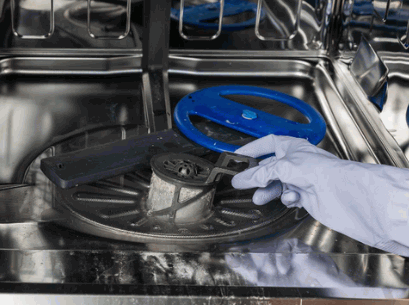
What Are The Signs That A Dishwasher Drain Needs To Be Cleaned?
Several signs indicate that your dishwasher drain requires cleaning, such as slow or incomplete drainage after a cycle, pooling water at the bottom of the appliance, persistent odors emanating from the dishwasher, and gurgling or unusual noises during operation. A visible backup of water in the sink connected to the dishwasher or the presence of debris in the drain filter are clear indicators of a clogged dishwasher drain.
Another common sign of a clogged dishwasher drain is when water backs up into the sink while the dishwasher is running, indicating a blockage in the drainage system. The air gap, a small cylindrical device located on the sink, can also provide clues; for instance, if it overflows during the dishwasher cycle, this suggests a problem with the drainage.
What Are The Materials Needed To Clean The Drain Of Dishwasher?
To effectively clean the drain of a dishwasher, you will need basic household items such as white vinegar, baking soda, a soft brush or cloth for scrubbing, the dishwasher's manual for guidance on accessing the drain components, specialized dishwasher cleaning products, and dishwashing liquid for a thorough rinse and final cleaning step.
White vinegar, often hailed for its natural cleaning prowess, serves as a potent disinfectant that can help eliminate stubborn grime and odors within the drain.
When combined with baking soda, a versatile cleaning agent with gentle abrasive properties, a fizzy reaction occurs, aiding in the dislodging of debris and grease buildup.
A soft brush or cloth is essential for physically scrubbing away any remaining residue or particles that may cling to the drain walls.
The dishwasher's manual is your ultimate resource for understanding the specific layout of your appliance's drain system and how to safely clean it.
Specialized dishwasher cleaning products are formulated to target and break down tough stains and mineral deposits, ensuring a thorough cleansing process.
For the final step, using dishwashing liquid helps remove any leftover cleaning agents and leaves the dishwasher smelling fresh and ready for use.
How To Clean The Drain Of Dishwasher?
Cleaning the drain of your dishwasher involves a series of steps to ensure the thorough removal of debris, clogs, and buildup. From removing the bottom rack to accessing the drain components, using vinegar and baking soda solution for cleaning, and checking the drain hose for any obstructions, each step plays a crucial role in maintaining a clean and functional dishwasher drain.
Once you have removed the bottom rack, inspect the drain area for any visible debris or clogs. Use a soft-bristle brush or a toothbrush to gently scrub away any residue.
Next, locate the filter in your dishwasher and remove it carefully. Clean the filter under running water to wash away any trapped food particles. For a deep clean, soak the filter in a vinegar and water solution to break down oils and grease.
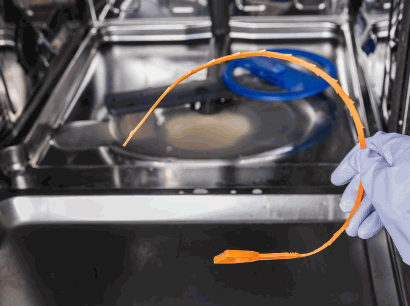
Step 1: Remove The Dishwasher's Bottom Rack
The first step in cleaning a dishwasher drain is to remove the bottom rack to access the drain area easily. Pull the rack outward gently, ensuring it is empty of any dishes or utensils, and set it aside for cleaning separately.
Once you have removed the bottom rack, it's essential to inspect it for any food particles or debris that may have accumulated. Use a damp cloth or sponge to wipe down the rack, paying special attention to any corners or crevices where grime tends to build up.
Before cleaning the rack, ensure that your dishwasher is unplugged to prevent any accidents. You may also want to wear protective gloves to avoid any sharp edges on the rack causing injury. When handling the rack, be mindful of any fragile parts and avoid applying excessive force to prevent damage.
Step 2: Locate The Drain And Remove Any Debris
After removing the bottom rack, locate the dishwasher drain and inspect it for any visible debris or clogs. Use a flashlight for better visibility and a tool such as a soft brush or cloth to gently remove the accumulated debris without damaging the drain components.
Proper lighting is crucial during this inspection process as it helps you identify even the smallest debris that might be causing drainage issues in your dishwasher.
Taking your time to carefully clean the drain ensures that you do not inadvertently push the debris further into the system, potentially worsening the clog.
When inspecting the drain, pay attention to any food particles, soap scum, or mineral buildup that could be obstructing the flow of water.
Remember to always handle the drain and its components delicately to avoid causing any damage that might lead to costly repairs in the future.
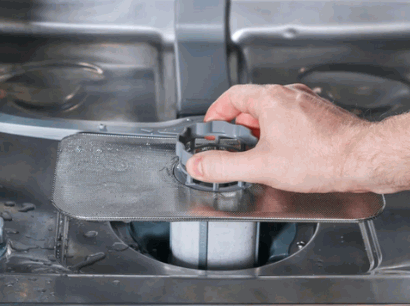
Step 3: Clean The Drain With Vinegar And Baking Soda Solution
To effectively clean the dishwasher drain, create a solution of white vinegar and baking soda. Pour the vinegar into the drain, followed by baking soda, and allow the mixture to fizz and break down residue and odor-causing particles for about 15-20 minutes.
This simple cleaning method harnesses the power of a chemical reaction between the vinegar and baking soda. When these two ingredients interact, they create a bubbling effect that helps dislodge stubborn debris clinging to the drain walls. Plus breaking down grime, this fizzy reaction releases carbon dioxide gas which further aids in pushing out dirt and eliminating unpleasant smells. The recommended duration of 15-20 minutes gives ample time for the mixture to work its magic, thoroughly cleansing the drain. Remember to run a hot water rinse cycle after to complete the process.
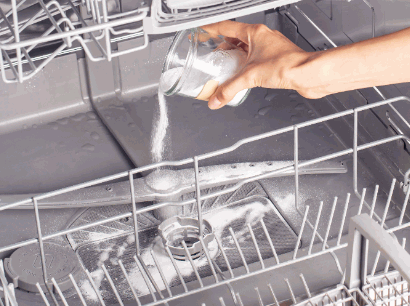
Step 4: Rinse The Drain With Hot Water
After the vinegar and baking soda solution have had time to work on the drain, rinse the drain thoroughly with hot water to flush out loosened debris and residue. This step helps in ensuring that the drain is free of any remaining particles and cleaning solution.
Using hot water is crucial in this step as it helps to dissolve and remove any stubborn residues that have been loosened by the vinegar and baking soda mixture. The hot water not only aids in rinsing away the debris effectively but also ensures that no traces of the cleaning agents are left behind. When rinsing, make sure to allow the hot water to flow through the drain at a steady pace, thoroughly cleaning all areas.
Step 5: Remove And Clean The Filter
Next, locate and remove the dishwasher filter for cleaning. Inspect the filter for any debris or blockages, and wash it under running water to remove trapped particles. Ensure the filter is completely clean before reinserting it back into the dishwasher.
Proper maintenance of the dishwasher filter is essential for the efficient functioning of your appliance. Debris and food particles can accumulate over time, causing drainage issues and affecting the cleanliness of your dishes. By regularly inspecting and cleaning the filter, you can prevent potential clogs and ensure that your dishwasher continues to work effectively.
Avoid using harsh chemicals or abrasive scrubbing pads when cleaning the dishwasher filter, as these can damage its delicate mesh structure. A gentle scrub with a soft brush or sponge should suffice to remove any stubborn residues. Check the manufacturer's instructions for specific cleaning recommendations tailored to your dishwasher model.
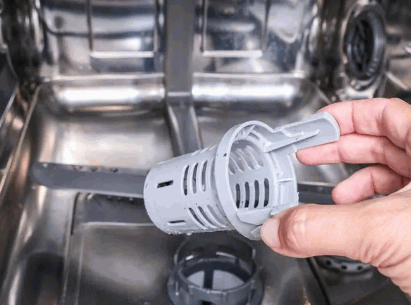
Step 6: Check The Drain Hose For Clogs
Inspect the dishwasher drain hose for any clogs or kinks that may obstruct the flow of water. Carefully straighten out any kinks and remove any visible clogs to ensure smooth drainage during the dishwasher's operation.
Check for debris accumulation at the connection points between the hose and the dishwasher or garbage disposal. Use a flashlight to look inside the hose for any blockages, such as food particles, grease, or small objects. It's advisable to detach the hose and clean it out if necessary, ensuring there are no stubborn blockages impeding the water flow. Running hot water through the hose after cleaning can help clear out any residual debris and maintain a clear pathway for efficient drainage.
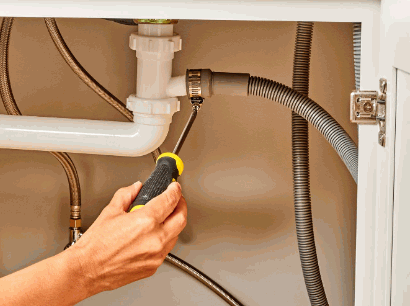
Step 7: Reassemble The Dishwasher And Run A Test Cycle
Once the drain components are clean and free of debris, reassemble the dishwasher by replacing the filter, rack, and any removed parts. Run a test cycle with the dishwasher empty to ensure that the drain functions properly and there are no leaks or drainage issues.
Proper maintenance of your dishwasher is crucial to ensure its efficient performance. Reassembling the machine correctly after cleaning the drain components is essential to prevent any future problems. Make sure the filter is secure in place, and the rack fits back perfectly. Running a test cycle post-cleaning allows you to observe the dishwasher's functionality firsthand. Monitor any unusual sounds or water leakage during this process. It's advisable to perform regular maintenance routines to extend the lifespan of your dishwasher.
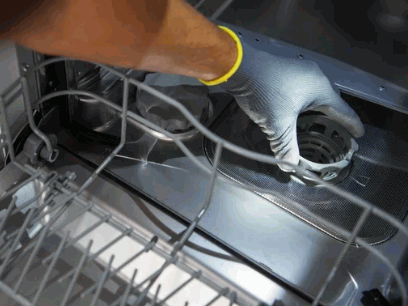
How Often Should The Dishwasher Drain Be Cleaned?
It is recommended to clean the dishwasher drain at least once a month or more frequently if you notice signs of drainage issues or unpleasant odors. Regular maintenance of the dishwasher drain helps prevent clogs, maintain optimal performance, and extend the lifespan of the appliance.
Plus preventing clogs and maintaining optimal performance, regular cleaning of the dishwasher drain also helps in avoiding bacterial buildup and ensuring hygienic dishwashing. By cleaning the drain on a monthly basis, you can significantly reduce the risk of mold growth and foul odors in your dishwasher.
To identify if your dishwasher drain needs cleaning, inspect it for any visible debris or standing water after a cycle. If you notice slow drainage or hear unusual noises during operation, it might indicate a clog that needs attention.
What Are The Alternative Methods To Clean The Drain Of Dishwasher?
Apart from using vinegar and baking soda, there are alternative methods to clean the dishwasher drain. You can opt for commercial dishwasher cleaners designed specifically for drain maintenance, utilize a plunger to dislodge stubborn clogs, or manually clean the drain pipe using a pipe brush and hot water to ensure thorough cleaning.
Commercial dishwasher cleaners are easily available in the market and are formulated to break down grease and grime that accumulate in the drain over time. They offer a convenient solution for those looking for a quick and effective fix.
On the other hand, plungers can be a simple yet powerful tool to tackle blockages by creating pressure to push through the clogs.
For a more hands-on approach, manual cleaning with a pipe brush and hot water allows you to physically remove any buildup along the drain pipe walls. This method ensures a comprehensive clean, particularly in hard-to-reach areas that may be missed by other cleaning techniques.
Using Commercial Dishwasher Cleaner
Commercial dishwasher cleaners offer a convenient solution for deep cleaning the dishwasher drain. These specialized products are formulated to break down tough residues, eliminate odors, and maintain the cleanliness of the drain system effectively. Follow the manufacturer's instructions for the proper use of the commercial cleaner for optimal results.
Using a commercial dishwasher cleaner not only removes grease buildup but also prevents clogs and ensures your dishwasher functions efficiently. By regularly cleaning the drain with a commercial cleaner, you can extend the lifespan of your dishwasher and improve its overall performance. These cleaners are designed to be safe for use in dishwashers and are effective in preventing mold and mildew growth in the drain system. Always check the product label for specific guidelines on application and dosage to achieve the best results.
Explore further: What Is The Best Kitchen Drain Unblocker
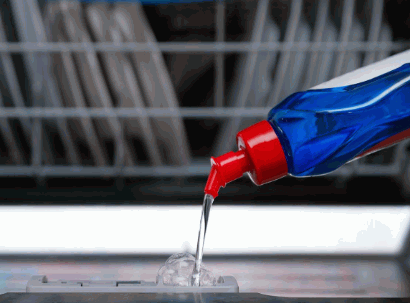
Using A Plunger
In case of persistent clogs in the dishwasher drain, using a plunger can help dislodge blockages and restore proper drainage.
When tackling a clog in your dishwasher drain, it's important to first ensure that the plunger's cup completely covers the drain opening. This tight seal is crucial in creating the necessary suction force to dislodge the blockage efficiently.
Once the seal is formed, gently push down on the plunger handle and then pull up in a pumping motion. This action helps to create pressure within the drain, breaking up the debris causing the clog. Remember to maintain a firm grip on the plunger and avoid using excessive force to prevent damage.
If the clog persists after the initial attempt, repeat the plunging process several times. Patience and consistent pressure are key in effectively clearing stubborn blockages in the dishwasher drain.
How To Prevent Future Clogs In The Dishwasher Drain?
To prevent future clogs in the dishwasher drain, incorporate regular maintenance and cleaning practices into your routine. Avoid rinsing excess food particles down the drain, use a mesh filter to catch debris, run hot water periodically to flush the drain, and ensure the air gap is clear to facilitate proper drainage and prevent backups.
Be cautious with what goes into your dishwasher; scraping off plates before loading them can significantly decrease the chances of clogs.
Regularly inspect and clean the filter to ensure it is free from blockages.
Consider using a dishwasher cleaning solution periodically to prevent the buildup of grease and soap scum.
Implementing these preventive measures not only keeps your dishwasher running smoothly but also extends its lifespan and ensures efficient performance.
